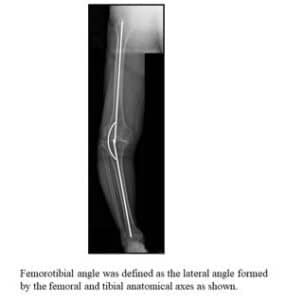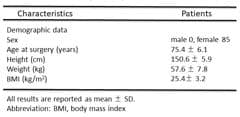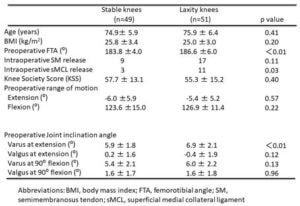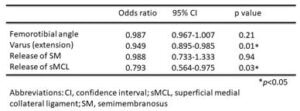Manabu Hino1,3, Shuji Nakagawa2, Hiroaki Inoue1, Yuta Fujii1, Kenta Kaihara1, Kenji Takahashi1, Yuji Arai2*
1Department of Orthopaedics, Graduate School of Medical Science, Kyoto Prefectural University of Medicine, Kyoto Japan
2Department of Sports and Para-Sports Medicine, Graduate School of Medical Science, Kyoto Prefectural University of Medicine, Kyoto Japan
3Department of Orthopaedics, Kyoto Interdisciplinary Institute Hospital of Community Medicine, Kyoto, Japan
*Corresponding Author: Yuji Arai, M.D. Ph.D., Department of Sports and Para-Sports Medicine, Graduate School of Medical Science, Kyoto Prefectural University of Medicine, 465 Kajiicho, Kawaramachi-Hirokoji, Kamigyo-ku, Kyoto 602-8566, Japan; Email: [email protected]
Published On: 02-06-2022
Copyright© 2022 by Arai Y, et al. All rights reserved. This is an open access article distributed under the terms of the Creative Commons Attribution License, which permits unrestricted use, distribution and reproduction in any medium, provided the original author and source are credited.
Abstract
Purpose: Adequate ligament balance is important for long-term outcomes after Total Knee Arthroplasty (TKA). We retrospectively evaluated preoperative factors and intraoperative medial soft tissue release techniques that affected adequate ligament balance after TKA for varus knee.
Method: One hundred knees with Osteoarthritis (OA) in women were included. X-rays were taken preoperatively and postoperatively with varus and valgus stress in the extension and flexion positions. Knees were postoperatively, classified as stable (n=49) or laxity (n=51).
Results: Factors associated with adequate ligament balance include joint inclination angle of varus at extension, and superficial Medial Collateral Ligament (sMCL) release. Postoperative ligament balance was significantly associated with preoperative joint inclination angle of varus at extension of 7°.
Conclusion: Preoperative lateral laxity in the extensor position under stress X-ray and sMCL release may affect postoperative ligament balance. A 7° preoperative lateral joint inclination may be useful in predicting postoperative ligament balance.
Keywords
Total Knee Arthroplasty; Ligament Balance; Preoperative Factor; Superficial Medial Collateral Ligament; Lateral Laxity; Varus-Valgus
Abbreviations
TKA: Total Knee Arthroplasty; OA: Osteoarthritis; SM: Semimenbranosus Tendon; sMCL: superficial Medial Collateral Ligament; PS: Posterior Stabilized; FTA: Femorotibial Angle; ROC: Receiver Operating Characteristic; AUC: Area Under the Curve
Introduction
Adequate ligament balance, defined as equal medial and lateral gaps during extension and flexion, is important for long-term outcomes after Total Knee Arthroplasty (TKA) [1]. Despite the recent development of various types of tensor devices, making it easier for the surgeon to assess and adjust ligament balance intraoperatively, complete ligament balance is still difficult to achieve [2]. Poor ligament balance can trigger instability of the knee joint and lead to various complications, including polyethylene wear, aseptic loosening, and pain [3-5]. The main factors associated with ligament balance include the preoperative condition of the knee and the manner of intraoperative soft tissue release. For example, preoperative coronal deformity has been reported to affect intraoperative ligament balance and intraoperative ligament balance has been found to affect postoperative outcomes [6-8]. In addition, medial soft tissue release in varus knees should be performed in stages to align with the lateral soft tissue. As varus deformities become more advanced, so does lateral soft tissue laxity, making it difficult to match the balance with the medial [9]. From experience, we know that a knee with severe preoperative varus deformity is likely to have an increased amount of intraoperative medial soft tissue release, resulting in poor intraoperative and postoperative ligament balance. However, even with the same degree of preoperative varus deformity, there are cases where postoperative ligament balance is adequate or poor. This may be due to differences in preoperative laxity and stiffness. The effect of preoperative ligament balance, rather than degree of preoperative deformity, on postoperative ligament balance is unclear and may be more useful for prognosis than assessing deformity. Regarding soft tissue release and gap, there are many evaluations comparing preoperative and intraoperative, and intraoperative and postoperative measures but few comparing preoperative and postoperative laxity by stress X-ray [7,8].
This retrospective study evaluated preoperative factors including ligament balance and intraoperative medial soft tissue release techniques that affected ligament balance after TKA for varus knees in women.
Materials and Methods
Patients
One hundred knees of 85 female patients that underwent primary TKA at our hospital between March 2014 and July 2017 were enrolled. All knees had OA and underwent posterior stabilized (PS) type primary TKA. Male knees were excluded due to differences in knee joint laxity between men and women [10]. Women with osteonecrosis, rheumatoid arthritis, or secondary knee OA were also excluded. Knees of 3 patients with osteonecrosis, and 1 with secondary knee OA were excluded for these reasons.
Varus knee was defined as a knee with preoperative femorotibial angle (FTA) ≥175°, which is the lateral angle formed by the femoral and tibial anatomical axes (Fig. 1).
All TKAs were performed by two experienced orthopedic surgeons (YA and SN). There was no difference in surgical technique, including medial release, between the two surgeons.
Surgical Technique
All patients were treated with a medial parapatellar approach and resections were performed with a measured resection technique. Zimmer NexGen LPS Flex was used in all patients who received PS-type implants. The medial soft tissue was released in stages, as described [11]. The deep Medial Collateral Ligament (dMCL) was released. The osteophytes were resected, with priority given to tibial coverage (Stage 1). The varus and valgus counterbalance in the extension and flexion positions was measured during the implant trial, during which a 40 lb. Joint distraction force was applied using a tensor to measure the inclination angle between the components.
If varus inclination angle was greater than 5°, first the Semimembranosus (SM) tendon and second the superficial Medial Collateral Ligament (sMCL) were further released (Stage 2). Reduction osteotomy was not performed. Knees with dissection greater than pes anserinus (Pes A) (Stage 3), as indicated by a constrained type implant, were excluded (Fig. 2).
Preoperative and Postoperative Assessment of Knee Instability by X-ray
X-rays were taken preoperatively and at 3-weeks postoperatively, using Telos SE in the extension position with 150 N of varus and valgus stress (Fig. 3) [12]. In the flexed position (90°), the femoral epicondylar axis imaging method was used, and approximately 150 N of varus and valgus stresses were applied manually with a 1.5 kg weight [13]. Preoperatively, the joint inclination angle was defined as the angle between the tibial joint surface and the distal femoral condyle in the extension position, and the angle between the tibial joint surface and the posterior femoral condyle in the flexion position. Postoperatively, the inclination angle between implants (implant inclination angle) was measured. Although some pain may be present at 3-weeks postoperatively, patients with severe postoperative pain were given NSAIDs medication or suppositories before stress X-ray examination to minimize the effect of pain as much as possible. The joint inclination and implant inclination angles were defined as positive when the lateral side was open.

Figure 1: Femorotibial angle. Femorotibial angle was defined as the lateral angle formed by the femoral and tibial anatomical axes as shown.

Figure 2: Medial soft tissue release. Stage 1: The dMCL was released. The osteophytes were resected. Stage 2: First the SM tendon, and second the sMCL were further released. Stage 3: Knees with dissection greater than pes A.

Figure 3: Joint inclination angle. (a) Preoperative extension. (b) Preoperative 90° flexion. (c) Postoperative extension. (d) Postoperative 90° flexion.
Assessment of Ligament Balance
Balanced equilibrium was defined as a postoperative implant inclination angle within 5° for both varus and valgus in extension and flexion [14]. Knees that satisfied all of the varus and valgus positions were defined as stable and those that failed to satisfy one of the positions were defined as laxity.
Statistical Analysis
All analyses were performed using EZR (Saitama Medical Center, Jichi Medical University), a graphical user interface for R (The R Foundation for Statistical Computing, version 2.13.0), with p-values <0.05 defined as statistically significant [8].
Statistical analyses were performed to assess correlations among: age, Body Mass Index (BMI), FTA, intraoperative medial release (SM release, sMCL release), Knee Society Score (KSS), preoperative ROM (extension angle, flexion angle), preoperative joint inclination angle by stress X-ray (varus at extension, valgus at extension, varus at flexion, and valgus at flexion). Single and multiple regression analyses were performed.
Receiver Operating Characteristic (ROC) curves were analyzed to determine joint inclination angle cut-off values and calculate their sensitivity, specificity, and the Area Under Curve (AUC). The total sample size (N = 100) provided 0.825 power to detect a difference in joint inclination angle of extension (degrees) between stable and laxity groups (α = 0.05, β = 0.20).
Results
Characteristics of the 85 included patients were shown in Table 1. Of the 100 knees, 49 were defined as stable and 51 as laxity postoperatively (Table 2). There were 74 medial soft tissue releases in Stages 1 and 2, respectively, with 26 detachments of the semimenbranosus tendon and further 14 of the sMCL. The relationship between preoperative joint inclination angle and medial soft tissue release is shown (Table 3). There was no significant difference between preoperative joint inclination angle and degree of medial soft tissue release. A postoperative implant inclination angle ≥6° was observed in 28 knees with varus and 7 with valgus in the extensor position, and in 26 with varus and 7 with valgus in the flexion position. sMCL release was required in 6 knees of varus at extension and 2 knees of valgus at extension, and 7 knees of varus at flexion and 3 of valgus at flexion, in the four knee positions. Laxity was seen in all four knee positions. Of the four knee positions, 18 knees had laxity at two positions but none at three or more positions. The implant inclination angles at 3-weeks postoperatively are shown in Table 4.
Single regression analysis revealed factors significantly influencing postoperative joint stability included preoperative FTA (Odds Ratio [OR] 0.975; 95% confidence interval [CI] 0.957-0.993, p <0.01), joint inclination angle of varus at extension (OR 0.936; 95% CI 0.892-0.982, p <0.01), and release of sMCL (OR 0.726; 95% CI 0.548-0.962, p =0.03) (Table 5). Multiple regression analysis of factors with p-values ≤0.1 on single regression analysis revealed joint inclination angle of varus at extension (OR 0.949; 95% CI 0.895-0.985, p =0.01) and sMCL release (OR 0.793; 95% CI 0.564-0.9752, p =0.03) were independent predictors of ligamentous balance (Table 6).
ROC curves were constructed to show the relationship between true positives and false positives, using joint inclination angle of varus at extension to predict good postoperative ligament balance. The angle cut-off values were determined to be 6 degrees, associated with an AUC of 0.66 (95% CI 0.56-0.77) (Fig. 4). Fisher’s exact test demonstrated a statistically significant association between postoperative ligament balance and preoperative joint inclination angle of varus at extension of 7° (p= 0.01) (Table 7).

Figure 4: ROC curves, showing a cut-off angle of 6 degrees associated with an AUC of 0.66 (95% confidence interval [CI] 0.56-0.77), a sensitivity of 47.1% and a specificity of 81.6%.

Table 1: Preoperative and intraoperative patient characteristics.

Table 2: Characteristics of patients with postoperative stable and laxity knees.

Table 3: Preoperative joint inclination angle in medial soft tissue release.

Table 4: Postoperative implant inclination angles at 3-weeks in stable and laxity knees.

Table 5: Single linear regression analysis of factors influencing postoperative joint stability.

Table 6: Multivariable regression analysis of factors influencing postoperative joint stability.

Table 7: Comparison between postoperative laxity and joint inclination angle.
Discussion
This study demonstrated that pre-TKA preoperative lateral laxity in the extensor position and intraoperative release of sMCL were associated with imbalanced postoperative ligament balance in varus OA knee.
Normal knees have a physiological lateral laxity of about 3-5° in the extension and flexion positions [15,16]. Stress imaging in the extension position revealed varus was 8° and valgus was 0° in OA knees with a mean FTA of 180°, whereas varus was 4° and valgus was 2° in normal knees [17]. The lateral soft tissues are stretched as the deformity of the varus increases the laxity of the knee, making the laxity different from normal. In this study, varus OA knees had more lateral laxity than normal knees. Preoperative varus at extension was 5.9° in postoperatively stable and 6.9° in postoperatively laxity knees, and the preoperative varus at flexion was 5.4° in postoperatively stable and 6.0° postoperatively laxity knees. PS type TKA for varus OA knees using the measured resection and gap techniques resulted in rectangular gaps in 28.0% and 44.4% of knees, respectively [2]. In the present study, PS type TKA performed on varus OA knees using the measured resection technique resulted in adequate ligament balance in about half of the stable knees, similar to previous findings. In contrast, the degree of preoperative varus was found to affect postoperative ligament balance. Preoperative advanced varus deformity has been associated with intraoperative gap asymmetry, with these knees being prone to residual intraoperative, immediately postoperative and postoperative instability [6,18-21]. Instability with preoperative stress and large preoperative FTA have been reported to increase intraoperative medial release, with instability with preoperative stress being a stronger predictor of increased intraoperative medial release than preoperative FTA [22,23]. Single regression analysis in the present study revealed joint inclination angle of varus at extension and preoperative FTA were significantly greater in laxity than stable knees, whereas multiple regression analysis revealed joint inclination angle of varus at extension was the only significant factor. Thus, lateral laxity in the extensor position, as assessed by preoperative stress X-ray, is associated with postoperative ligament imbalance. Furthermore, this study found that a preoperative lateral joint inclination angle >7 degrees was unlikely to result in adequate postoperative ligament balance. A lateral joint inclination angle of 7 degrees in 150 N varus and valgus stress x-rays with Telos SE may be useful in predicting postoperative ligament balance.
Soft tissue release is a surgical procedure that affects subsequent ligament balance. In varus OA knee, the medial soft tissue does not contract and lateral soft tissue laxity increases as the disease progresses [9,24,25]. Therefore, TKA of varus OA knee is performed in stages of medial release to match the tense state of the relaxed lateral soft tissue. If the preoperative varus deformity is severe, the amount of medial release must be increased; however, if this release is excessive, laxity will occur and clinical outcomes will be poorer. Semimembranosus tendon is one of the medial stabilizing structures, but semimenbranosus tendon release did not worsen laxity in this study. In contrast, the sMCL, which is released during Stage 2 of Clayton’s method, plays an important role in the medial stability of the knee joint, not only in the coronal plane but in the sagittal and axial planes. When medial release under navigation using cadavers was performed in stages, sMCL release resulted in excessive instability [26]. The present study found the occurrence of sMCL release differed significantly in stable and laxity knees. Multiple regression analysis revealed sMCL release was significantly associated with ligament balance (p=0.03). In general, patients with severe preoperative varus may need sMCL release, and it was expected that patients with preoperative severe joint inclination angle would need sMCL release. The results in Table 3 show no significant difference in the relationship between preoperative joint inclination angle and medial soft tissue release. In this study, laxity was observed at all four postoperative knee positions in patients who underwent sMCL release, and in some cases, laxity occurred at two positions, indicating that sMCL release affects both postoperative varus and valgus laxity. sMCL is the most important medial stabilizing structure, involved in about 60% of valgus from extension to flexion, and is reported to increase valgus laxity due to release [27]. On the other hand, extensive medial release also increases the lateral gap and affects varus laxity, although to a lesser amount than medial gap [28]. It has also been pointed out that sMCL release may lead to a combined laxity pattern [27]. Therefore, it is possible that sMCL release affects both varus and valgus postoperative ligament imbalance.
This study had several limitations. First, FTA and lower limb deformity may not coincide in some knees. The joint inclination angle may be more advanced in knees with tibial medial defects and depression. Second, tibial medial release volume was the only intraoperative factor assessed in this study, making future studies necessary to clarify the elements of intraoperative balance adjustment. Third, although the results of this analysis showed no significant difference between preoperative inclination angle and sMCL release, sMCL release is generally required in patients with preoperative severe varus, and sMCL release may be necessary in patients with preoperative severe joint inclination angle.
Conclusion
Preoperative lateral laxity in the extensor position and sMCL release may affect postoperative ligament balance in OA knees undergoing TKA. A lateral joint inclination of 7 degrees on preoperative varus at extension, as determined by stress imaging, may be useful in predicting postoperative ligament balance.
Conflict of Interest
It is stated that there are no conflicts of interest.
Ethical Approval
All procedures performed in studies involving human participants were in accordance with the ethical standards of the institutional and/or national research committee and with the 1964 Helsinki declaration and its later amendments or comparable ethical standards. This study was approved by the Institutional Review Board (Approval Number ERB-C221).
Informed Consent
Informed consent was obtained from all individual participants included in the study.
References
- Paxton EW, Furnes O, Namba RS, Inacio MCS, Fenstad AM, Havelin LI. Comparison of the Norwegian knee arthroplasty register and a United States arthroplasty registry. J Bone Joint Surg Am. 2011;3:20-30.
- Matsumoto T, Muratsu H, Kawakami Y, Takayama K, Ishida K, Matsushita T, et al. Soft-tissue balancing in total knee arthroplasty: Cruciate-retaining versus posterior-stabilised, and measured-resection versus gap technique. Int Orthop. 2014;38:531-7.
- Aunan E, Kibsgård T, Clarke-Jenssen J, Röhrl SM. A new method to measure ligament balancing in total knee arthroplasty: Laxity measurements in 100 knees. Arch Orthop Trauma Surg. 2012;132:1173-81.
- Babazadeh S, Stoney J, Lim K, Choong P. The relevance of ligament balancing in total knee arthroplasty: how important is it? A systematic review of the literature. Orthop Rev (Pavia). 2009;1:26.
- King JJ, Chakravarty R, Cerynik DL, Black A, Johanson NA. Decreased ratios of lateral to medial patellofemoral forces and pressures after lateral retinacular release and gender knees in total knee arthroplasty. Knee Surg Sports Traumatol Arthrosc. 2013;21:2770-8.
- Matsumoto T, Muratsu H, Kubo S, Matsushita T, Kurosaka M, Kuroda R. The influence of preoperative deformity on intraoperative soft tissue balance in posterior-stabilized total knee arthroplasty. J Arthroplasty. 2011;26:1291-8.
- Aunan E, Kibsgård TJ, Diep LM, Röhrl SM. Intraoperative ligament laxity influences functional outcome 1 year after total knee arthroplasty. Knee Surgery, Sport Traumatol Arthrosc. 2015;23:1684-92.
- Nakano N, Matsumoto T, Muratsu H, Takayama K, Kuroda R, Kurosaka M. Postoperative knee flexion angle is affected by lateral laxity in cruciate-retaining total knee arthroplasty. J Arthroplasty. 2016;31:401-5.
- Okamoto S, Okazaki K, Mitsuyasu H, Matsuda S, Iwamoto Y. Lateral soft tissue laxity increases but medial laxity does not contract with varus deformity in total knee arthroplasty knee. Clin Orthop Relat Res. 2013;471:1334-42.
- Deep K. Collateral ligament laxity in knees: What is normal? Clin Orthop Relat Res. 2014;472:3426-31.
- Clayton ML, Thompson TR, Mack RP. Correction of alignment deformities during total knee arthroplasties: staged soft-tissue releases. Clin Orthop Relat Res. 1986;202:117-24.
- Yoshihara Y, Arai Y, Nakagawa S, Inoue H, Ueshima K, Fujiwara H, et al. Assessing coronal laxity in extension and flexion at a minimum of 10 years after primary total knee arthroplasty. Knee Surgery, Sport Traumatol Arthrosc. 2016;24:2512-6.
- Kanekasu K, Kondo M, Kadoya Y. Axial radiography of the distal femur to assess rotational alignment in total knee arthroplasty. Clin Orthop Relat Res. 2005:193-7.
- Heesterbeek PJC, Verdonschot N, Wymenga AB. In vivo knee laxity in flexion and extension: A radiographic study in 30 older healthy subjects. Knee. 2008;15:45-9.
- Okazaki K, Miura H, Matsuda S, Takeuchi N, Mawatari T, Hashizume M, et al. Asymmetry of mediolateral laxity of the normal knee. J Orthop Sci. 2006;11:264-6.
- Tokuhara Y, Kadoya Y, Nakagawa S, Kobayashi A, Takaoka K. The flexion gap in normal knees. An MRI study. J Bone Jt Surg – Ser B. 2004;86:1133-6.
- Ishii Y, Noguchi H, Matsuda Y, Kiga H, Takeda M, Toyabe SI. Preoperative laxity in osteoarthritis patients undergoing total knee arthroplasty. Int Orthop. 2009;33:105-9.
- Matziolis G, Matziolis D, Perka C. Pre-operative frontal plane malalignment predicts the extension gap asymmetry in knee osteoarthritis. Int Orthop. 2012;36:79-82.
- Morcos MW, Lanting BA, Webster J, Howard JL, Bryant D, Teeter MG. Effect of medial soft tissue releases during posterior-stabilized total knee arthroplasty on contact kinematics and patient-reported outcomes. J Arthroplasty. 2019;34:1110-5.
- Yagishita K MTYHSK. The relationship between postoperative ligament balance and preoperative varus deformity in total knee arthroplasty. Bull Hosp Jt Dis. 2001;60:23-8.
- Sekiya H, Takatoku K, Takada H, Sasanuma H, Sugimoto N. Postoperative lateral ligamentous laxity diminishes with time after TKA in the varus knee. Clin Orthop Relat Res. 2009;467:1582-6.
- Lee O-S, Elazab A, Lee YS. Preoperative varus-valgus stress angle difference is valuable for predicting the extent of medial release in varus deformity during total knee arthroplasty. Knee Surg Relat Res. 2019;31:12-8.
- Ahn JH, Lee SH, Yang TY. Varus-valgus stress radiograph as a predictor for extensive medial release in total knee arthroplasty. Int Orthop. 2016;40:1639-46.
- Ushio T, Mizu-uchi H, Okazaki K, Miyama K, Akasaki Y, Ma Y, et al. Medial soft tissue contracture does not always exist in varus osteoarthritis knees in total knee arthroplasty. Knee Surgery, Sport Traumatol Arthrosc. 2019;27:1642-50.
- Kuroyanagi Y, Nagura T, Kiriyama Y, Matsumoto H, Otani T, Toyama Y, et al. A quantitative assessment of varus thrust in patients with medial knee osteoarthritis. Knee. 2012;19:130-4.
- Mullaji A, Sharma A, Marawar S, Kanna R. Quantification of effect of sequential posteromedial release on flexion and extension gaps. A computer-assisted study in cadaveric knees. J Arthroplasty. 2009;24:795-805.
- Athwal KK, Daou HE, Kittl C, Davies AJ, Deehan DJ, Amis AA. The superficial medial collateral ligament is the primary medial restraint to knee laxity after cruciate-retaining or posterior-stabilised total knee arthroplasty: effects of implant type and partial release. Knee Surg Sports Traumatol Arthrosc. 2016;24:2645-55.
- Hunt NC, Ghosh KM, Athwal KK, Longstaff LM, Amis AA, Deehan DJ. Lack of evidence to support present medial release methods in total knee arthroplasty. Knee Surg Sports Traumatol Arthrosc. 2014;22:3100-12.
Article Type
Research Article
Publication History
Received On: 10-05-2022
Accepted On: 25-05-2022
Published On: 02-06-2022
Copyright© 2022 by Arai Y, et al. All rights reserved. This is an open access article distributed under the terms of the Creative Commons Attribution License, which permits unrestricted use, distribution, and reproduction in any medium, provided the original author and source are credited.
Citation: Arai Y, et al. Preoperative Lateral Laxity in the Extensor Position and Intraoperative Medial Soft Tissue Release Affect Postoperative Ligament Balance in Osteoarthritis Knees Undergoing TKA in Women. J Surg Res Prac. 2022;3(2):1-12.

Figure 1: Femorotibial angle. Femorotibial angle was defined as the lateral angle formed by the femoral and tibial anatomical axes as shown.

Figure 2: Medial soft tissue release. Stage 1: The dMCL was released. The osteophytes were resected. Stage 2: First the SM tendon, and second the sMCL were further released. Stage 3: Knees with dissection greater than pes A.

Figure 3: Joint inclination angle. (a) Preoperative extension. (b) Preoperative 90° flexion. (c) Postoperative extension. (d) Postoperative 90° flexion.

Figure 4: ROC curves, showing a cut-off angle of 6 degrees associated with an AUC of 0.66 (95% confidence interval [CI] 0.56-0.77), a sensitivity of 47.1% and a specificity of 81.6%.

Table 1: Preoperative and intraoperative patient characteristics.

Table 2: Characteristics of patients with postoperative stable and laxity knees.

Table 3: Preoperative joint inclination angle in medial soft tissue release.

Table 4: Postoperative implant inclination angles at 3-weeks in stable and laxity knees.

Table 5: Single linear regression analysis of factors influencing postoperative joint stability.

Table 6: Multivariable regression analysis of factors influencing postoperative joint stability.

Table 7: Comparison between postoperative laxity and joint inclination angle.


